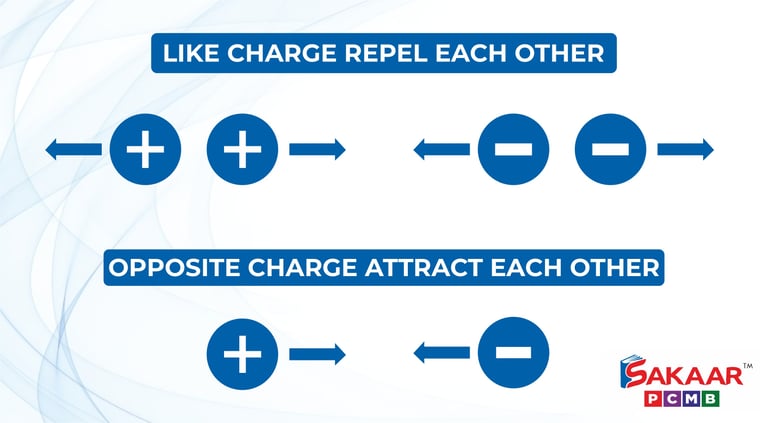Electric Charge


Electric charge stands as a foundational concept in physics, serving as a cornerstone for understanding the physical world. In this article, we will explore the intricate nature of electric charge, its properties, and various charging methods. This comprehensive discussion aims to provide a clear understanding of electric charge and its significance in the realm of physics.
Table of Contents
What is an Electric Charge?
Definition of Electric Charge
Types of Electric Charge
Is Electric Charge a Vector Quantity?
Measurement of Electric Charge
Properties of Electric Charge
Additivity of Electric Charge
Conservation of Electric Charge
Quantization of Electric Charge
Coulomb’s Law
Methods of Charging
Charging by Friction
Charging by Conduction
Charging by Induction
Overview of Electric Charge
Frequently Asked Questions – FAQs
In the CBSE curriculum, a thorough understanding of electric charge and its types is essential.
What is an Electric Charge?
Definition of Electric Charge
Electric charge is a fundamental property inherent in subatomic particles, leading to the experience of force in the presence of electric and magnetic fields. These fields exert influence on charged particles, resulting in observable effects.
Electric charge exists in two primary types: positive and negative charges. Positive charges are attributed to protons, subatomic particles residing in the nucleus of an atom, represented by the symbol “+”. Conversely, negative charges are associated with electrons, orbiting the atomic nucleus, denoted by the symbol “-“.
Types of Electric Charge
The distinction between positive and negative charges is crucial for understanding the behavior of electrically charged objects. Opposite charges, such as positive and negative, attract each other, whereas like charges, such as positive and positive or negative and negative, repel each other. This principle forms the basis for various electromagnetism concepts and is vital for understanding charged particle interactions
When an object carries a negative charge, it indicates an excess of electrons compared to protons. Conversely, a positive charge signifies an excess of protons relative to electrons.
It is important to note that when an equal number of positive and negative charges are present, they cancel each other out, resulting in a neutral state for the object.
By grasping the definition of electric charge and recognizing the significance of positive and negative charges, one can understand the fundamental principles governing electricity and magnetism.
Note: In the context of electric charge, the terms “attraction” and “repulsion” describe how charges interact with each other.
Measurement of Electric Charge The unit of electric charge is the Coulomb.
“One coulomb is the quantity of charge transferred in one second.”
Mathematically, the definition of a coulomb is represented as:
Q = I.t
In this equation, Q represents the electric charge, I denotes the electric current, and t stands for time.
Related Links Ampere Electric Field of a Point Charge Current Electricity Static Electricity Properties of Electric Charge Electric charge possesses several important properties that help us understand its behavior. Let’s explore these properties:
Additivity of Electric Charge When charges combine, their magnitudes add up algebraically. For example, if we have a positive charge of +3 units and a negative charge of -2 units, the resulting charge would be +1 unit.
Conservation of Electric Charge:
In an isolated system, electric charge is conserved. This means that the total electric charge within the system remains constant over time. The algebraic sum of all the charges present in the system remains the same.
Quantization of Electric Charge:
Electric charge comes in discrete, indivisible units called elementary charges. The smallest unit of electric charge is the charge carried by an electron, which is approximately -1.6 x 10-19 coulombs. This quantization of charge implies that electric charge cannot be divided into smaller parts.
Understanding these properties helps us comprehend the behavior of electric charges and their importance in various scientific phenomena.
Note: “Algebraic sum” refers to adding charges, considering their signs (+ or -). To understand the properties of charge in detail, read the article below:
Is Electric Charge a Vector Quantity?
No, electric charge is not a vector quantity; it is a scalar quantity. While vectors have both magnitude and direction and follow vector addition laws like the triangle law and parallelogram law, electric charge does not exhibit these properties. When currents meet at a junction, the resulting current is determined by the algebraic sum of the individual currents rather than their vector sum. Thus, electric charge is considered a scalar quantity, despite having magnitude and direction.
Measuring Electric Charge
Coloumb is the unit of electric charge.
“One coulomb is the quantity of charge transferred in one second.”
Mathematically, the definition of a coloumb is represented as:
Q = I.t
Coulomb’s Law
Coulomb’s Law We know that like charges repel each other, while unlike charges attract. However, have you ever wondered about the strength of these forces acting between charges? Coulomb’s Law offers us a method to calculate this force precisely.
According to Coulomb’s Law, the magnitude of the electrostatic force between two point charges is directly proportional to the product of their magnitudes and inversely proportional to the square of the distance separating them.
The Coulomb’s Law is given by the expression:
Where Fe is the electric force, q1 and q2 are electric charges, k is the Coulomb’s constant 8.988×109 N⋅m2/C2 and r is the distance of separation.
By applying Coulomb’s Law, we can quantitatively determine the strength of the electric force between charges and gain valuable insights into their interactions. This fundamental principle holds great significance in the field of electromagnetism and enables us to analyze various electrical phenomena.
Through the application of Coulomb’s Law, scientists and researchers have been able to uncover the intricate workings of electric forces and comprehend their profound impact on the world around us.
Read More: Coulomb’s Law
Methods of Charging The process of supplying electric charge to an object or causing it to lose electric charge is referred to as charging. There are three distinct methods by which an initially uncharged object can acquire charge:
Charging by Friction (triboelectric charging)
Charging by Conduction
Charging by Induction
Charging by Friction
When two objects are rubbed against each other, a transfer of charge occurs. In this process, one of the objects loses electrons while the other gains electrons. The object losing electrons becomes positively charged, while the object gaining electrons becomes negatively charged. This phenomenon, where both objects become charged due to friction, is commonly known as electrification by friction.
Charging by Conduction
Charging by conduction involves bringing an uncharged object in close proximity to a charged object. If the charged object has an unequal number of protons and electrons, the uncharged object will discharge electrons to achieve stability. This transfer of charge through contact is known as charging by conduction.
Charging by Induction
Charging by induction refers to the process of charging an uncharged object by merely bringing it close to a charged object, without any direct physical contact. Through induction, the charged object induces a redistribution of charges in the uncharged object, resulting in the acquisition of charge.
By understanding these different methods of charging, we can explore the fascinating ways in which objects become charged through friction, contact, or proximity. The study of charging provides valuable insights into the behavior and interaction of electric charges in various scenarios.
Overview of Electric Charge
Definition: Electric Charge is the property of subatomic particles that causes it to experience a force when placed in an electromagnetic field.
Symbol: Q
Formula: Q = I.t
SI Unit: Coulomb
Other Units: Faraday, Ampere-Hour
Frequently Asked Questions – FAQs
Q1. What is electric charge?
Electric charge is a fundamental property of matter. It refers to the intrinsic property of particles that gives rise to electric forces and interactions.
Q2. How are electric charges distributed within the atom?
Within an atom, electric charges are distributed among subatomic particles. Protons, found in the nucleus, carry positive charges, while electrons, which orbit the nucleus, carry negative charges. Neutrons, also present in the nucleus, have no electric charge.
Q3. What are the positively charged subatomic particles called?
The positively charged subatomic particles are called protons. They have a positive electric charge. When the matter has more protons than electrons, then it is said to have a positive charge.
Q4. When will an electric charge be negative?
An electric charge will be negative when an object has an excess of electrons.
Q5. Why is an electric charge a scalar quantity?
When two currents meet at a junction, the resultant current of these will be an algebraic sum and not the vector sum. Therefore, an electric current is a scalar quantity.
Q6. What is the unit for measuring electric charge?
The unit for measuring electric charge is the coulomb (C). It is named after the French physicist Charles-Augustin de Coulomb.
Q7. Define one coulomb.
One coulomb is the quantity of charge transferred in one second.
Q8. What are the types of electric charges?
The two types of electric charges are positive and negative charges. Positive charges are associated with protons, while negative charges are associated with electrons.
Q9. How is an uncharged object charged?
An uncharged object can be charged through various methods, such as charging by friction (rubbing two objects together), charging by conduction (contact with a charged object), or charging by induction (bringing an uncharged object close to a charged object without direct contact).
Q10. What are the other units of electric charge?
Faraday and Ampere-Hour are the other units of electric charge. Apart from the coulomb, smaller units of electric charge include the microcoulomb (μC), nanocoulomb (nC), and picocoulomb (pC). These units are used to measure smaller quantities of electric charge.




Join Best Learning Program....




